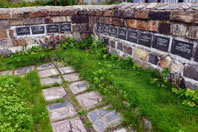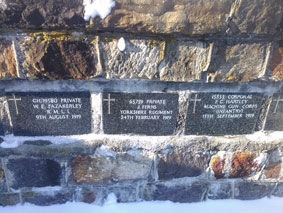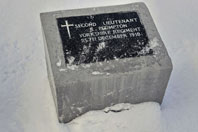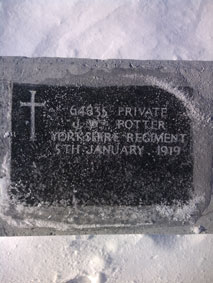 |
Yorkshire
Regiment War Graves, - Murmansk New British Cemetery, Russia |
 |
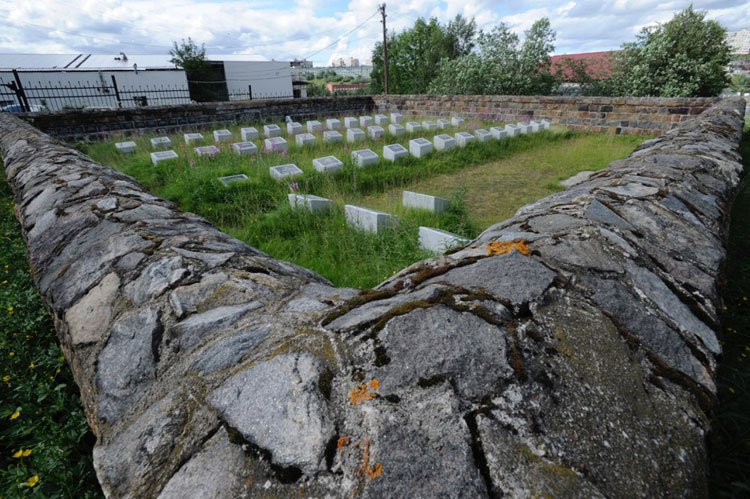 Murmansk
New British Cemetery (1)
Murmansk
New British Cemetery (1)
Photo : Lev
Fedoseyev
Murmansk New British Cemetery was made in 1930. The 40 burials were moved in from the Old British Cemetery that had been used by No 86 General Hospital in 1918-19.The special memorials commemorate officers and men known to have been buried in cemeteries elsewhere in the Murman area.
The cemetery now contains 83 burials and commemorations of the First World War.
3 soldiers of the Yorkshire Regiment are buried in this cemetery. The headstone for one is shown, below, together with the commemorative plaque for another.
Further information on this cemetery has been provided by Uncle Pasha , and this information is provided below.
As well as the photo above, several other photos of the cemetery are shown on this page. In addition to the photo by Lev Fedoseyev, we are very grateful to photos taken by Oleg Filonok of the cemetery and headstones.
Select a small sized image of a headstone / commemoration, for a larger sized image to open in a new window.
| Private James Ferns. 63739. 13th Battalion the Yorkshire Regiment, formerly 23375 H L I. Died 24 February 1919. Born Barony (Lanarkshire), Enlisted Glasgow , Resided Dennistown (Glasgow). Buried Kem Cemetery. (The commemorative plaque for Private Ferns is on the extreme right of the top photo.) Top photo by Oleg Filonok A I Chepaya has taken a close up of Private Ferns commemorative plaque, which can be seen in the lower photo. |
|
| 2nd Lieutenant Robert Plumpton.
6th Battalion Yorkshire Regiment. Killed 25 December 1918. The following biographical notes on Lieutenant Plumpton are taken from Robert Coulson's Biographies of Yorkshire Regiment Officers who lost their lives in the First World War;- "Robert Plumpton initially served as a private soldier in the ranks of the London Regiment before being commissioned into the Yorkshire Regiment. The 6th Battalion Yorkshire Regiment were disbanded in mid 1918 and a small cadre of officers and men proceeded to Mychett Camp at Aldershot. Through the summer of 1918 the 6th Battalion was reconstituted at Aldershot to form part of the North Russia Expeditionary Force. Robert Plumpton joined the battalion at Mychett Camp and on October 16th 1918 sailed from Dundee bound for Murmansk. 2nd Lt Plumpton and the battalion were then laid up in Kirkwall for two weeks before finally arriving in Murmansk on November 26th where they were billetted. In a strange occurrence in the history of the Great War 2nd Lt Robert Plumpton was murdered on Christmas Day of 1918. The following is a direct quote from the history of the Green Howards, “On Christmas Day a tragedy befell the 6th Green Howards, 2nd Lt Robert Plumpton being found murdered in a ravine close to Murmansk. It was not for some days that any evidence could be found implicating anybody but on January 14th 1919 a party from “B” company made a raid on certain Russian quarters and here Robert Plumpton’s watch and stolen government stores were discovered. The owner was tried and shot on February 5th 1919”." Photo by Oleg Filonok |
|
| Private Joseph William Potter. 64835.
6th Battalion the Yorkshire Regiment, formerly 17/30114 Cheshire Regt. Died 5 January 1919. Born Stockton-on-Tees, Enlisted Liverpool, Resided St. Helen's (Lancs). The website, St. Helens Roll of Honour, provides the following additional information on Private Joseph William Potter, - obtained from the "Burnley Reporter" of 15 January 1919. His residence in Burnley was at 13 Argyle Street. In the 1911 Census he was shown as being a "Miner Drawer" and living with his brother and family at 16 Argyle Street, Burnley. He died of poisoning. Photo : A I Chepaya |
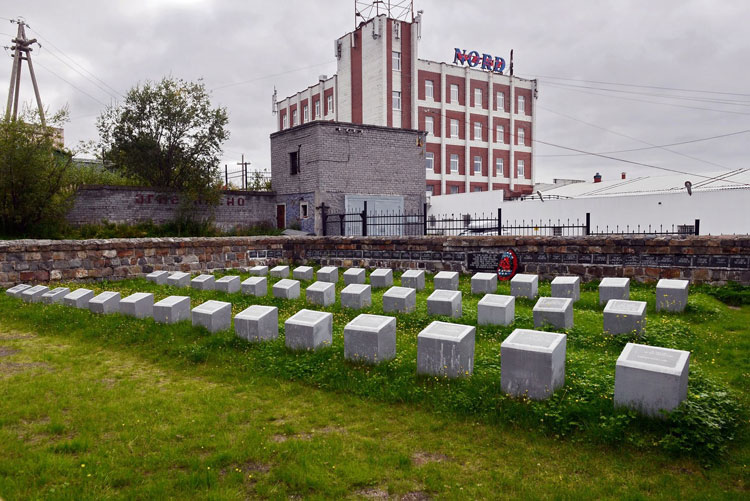 Murmansk
New British Cemetery (2)
Murmansk
New British Cemetery (2)
Photo : Oleg
Filonok
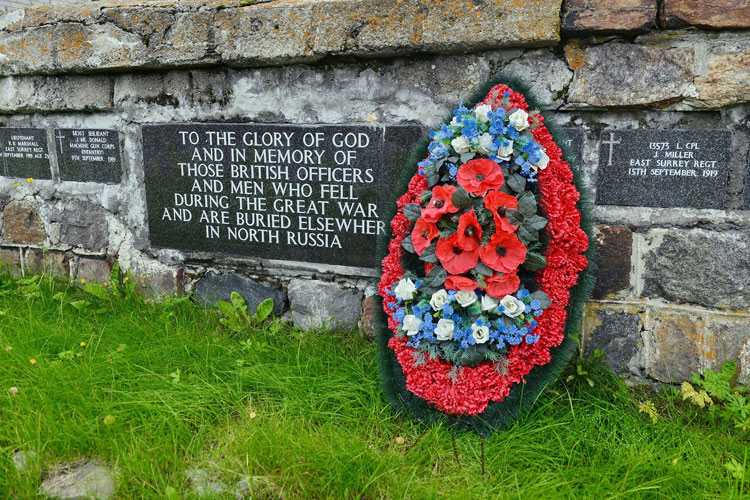 Murmansk
New British Cemetery - the Commemoration of Those Who are Buried Elsewhere
in Russia
Murmansk
New British Cemetery - the Commemoration of Those Who are Buried Elsewhere
in Russia
Photo : Oleg
Filonok
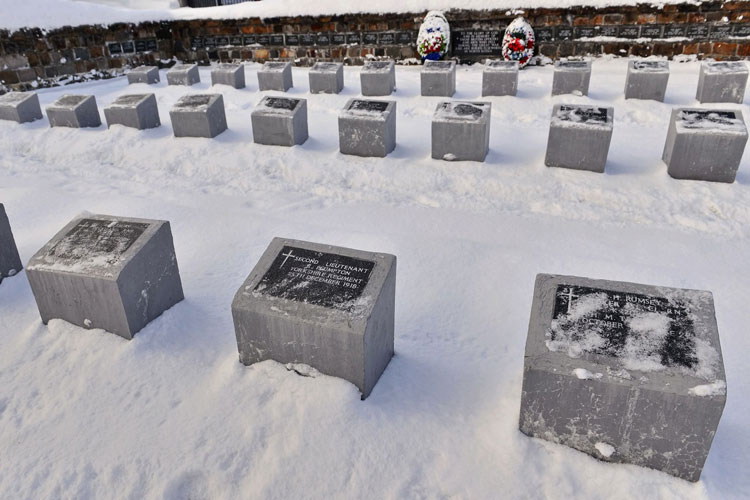 Murmansk
New British Cemetery - Lieutenant Plumpton's Headstone in the Centre Foreground.
Private Potter's Headstone is in the front row, on the right.
Murmansk
New British Cemetery - Lieutenant Plumpton's Headstone in the Centre Foreground.
Private Potter's Headstone is in the front row, on the right.
Photo : Oleg
Filonok
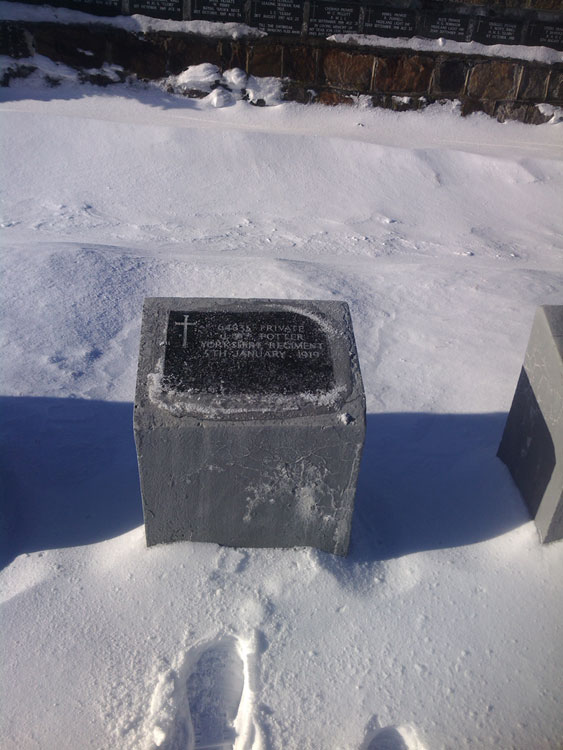
Murmansk New British Cemetery - Private Potter's Headstone
Photo : A I Chepaya
Further Information on Murmansk Cemetery from the website by Uncle Pasha.
The British soldiers who died in 1917-1919 were first buried together with Russians at a place where the rides park used to be on the Burkova street. But in the 20s (or in the 30s according to other sources) it was decided to move the remains of foreigners elsewhere… Several dozen of graves were opened, coffins dragged out and carted to their present location. What is now known as Planernoye pole (“glider field”) at the time was far beyond the city limits and was hardly visited by people. The desire to let the memory of the dead British to disappear is clearly seen in this decision. That’s when the wall around the cemetery was built. At the end of 80s and the beginning of 90s the cemetery truly fell into neglect – the wall partly fell apart, and nobody was looking after the graves. But soon the times had changed: the public, and then the authorities remembered to whom Murmansk owes its survival in the revolution and during the Civil War. In 1991 the abandoned cemetery was turned into a memorial and currently it is municipal property… Forty headstones, built in 1991 and financed by the UK veterans, in the shape of low stellas of the same shape, are arranged in three rows. Each stella has a tablet with the information on the dead, and often with an epitaph in his honour. Another 38 tablets are part of the wall…”
